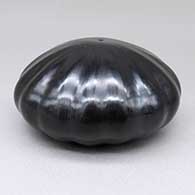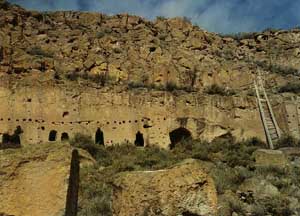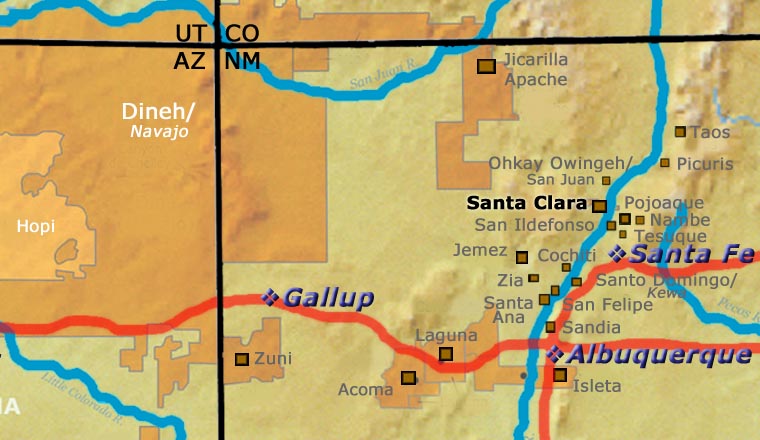
David Baca
Santa Clara

David Yellow Mountain Baca was born in 1951, the son of Angela Baca and Antonio Baca. He is the older brother of Leona Baca and Alvin Baca. They all learned how to make pottery through watching and working with their mother and grandmother, Severa Tafoya, as they were growing up at Santa Clara Pueblo.
David makes mostly red and black melon jars with multiple carved ribs and elongated necks. He also makes red and black jars and bowls with sgraffito designs and red and black clay pipes.
He was a participant in the Santa Fe Indian Market and Eight Northern Pueblos Arts & Crafts Show for many years. He won multiple ribbons in that time. His work has been exhibited in galleries in Arizona, New Mexico, Colorado, Utah, California, Tennessee, Washington and New Jersey.
David is also an accomplished musician, playing guitar and harmonica in his family's band for many years. They played clubs and special occasions all over northern New Mexico.
Some Exhibits that Featured Works by David
- Images, Artists, Styles: Recent Acquisitions from the Heard Museum Collection. Heard Museum North. Scottsdale, AZ. July, 2001 - December, 2001
- Symbolism in the Abstract. Gallery 10. Scottsdale, AZ December 20, 1991 - January 31, 1992
Some Awards Won by David
- 2018 Santa Fe Indian Market: Mela Youngblood Memorial Award for Best in Traditional Santa Clara Pueblo Pottery, Traditional Methods with a Contemporary Shape or Design, Black, Any Size
- 2004 Santa Fe Indian Market. Class II - Pottery, Div. B - Traditional pottery, undecorated, Cat. 903 - Melon bowls and melon jars, Second Place
- 2001 Santa Fe Indian Market. Class II - Pottery; Div. B - Traditional pottery, Category 902 - melon bowls and jars, black: Third Place - Category 903 - melon bowls and jars, all others: First Place
- 2000 Santa Fe Indian Market. Class II - Pottery, Div. B - Traditional pottery, Category 902 - melon bowls and jars, black: Second Place
- 1996 Santa Fe Indian Market. Class II - Pottery, Div. B - Traditional pottery, Category 903 - Melon Bowls: Second Place
- 1994 Santa Fe Indian Market. Class II - Pottery, Division B - traditional pottery, undecorated Category 904 - Melon bowls and jars: Second Place
- 1992 Santa Fe Indian Market. Class II - Pottery, Category 908 - miscellaneous: Third Place
- 1990 Santa Fe Indian Market. Class VI - Misc. Art, Division B - stone and wood, Category 2601 - pipes: Third Place
- 1983 Santa Fe Indian Market. Class V - Weaving/baskets, Division D - misc. crafts: Second Place
100 West San Francisco Street, Santa Fe, New Mexico 87501
(505) 986-1234 - www.andreafisherpottery.com - All Rights Reserved

Santa Clara Pueblo

Ruins at Puye Cliffs, Santa Clara Pueblo
Santa Clara Pueblo straddles the Rio Grande about 25 miles north of Santa Fe. Of all the pueblos, Santa Clara has the largest number of potters.
The ancestral roots of the Santa Clara people have been traced to ancient pueblos in the Mesa Verde region in southwestern Colorado. When that area began to get dry between about 1100 and 1300 CE, some of the people migrated eastward, then south into the Chama River Valley where they constructed several pueblos over the years. One was Poshuouinge, built about 3 miles south of what is now Abiquiu on the edge of the Jemez foothills above the Chama River. Eventually reaching two and three stories high, and with up to 700 rooms on the ground floor, Poshuouinge was occupied from about 1375 CE to about 1475. Drought then again forced the people to move, some of them going to the area of Puye (on the eastern slopes of the Pajarito Plateau of the Jemez Mountains) and others downstream to Ohkay Owingeh (San Juan Pueblo, along the Rio Grande). Beginning around 1580 CE, drought forced the residents of the Puye area to relocate closer to the Rio Grande and they founded what we now know as Santa Clara Pueblo on the west bank of the river, with San Juan Pueblo to the north and San Ildefonso Pueblo to the south.
In 1598 the seat of Spanish government was established at Yunque, near San Juan Pueblo. The Spanish proceeded to antagonize the Puebloans so badly that that government was moved to Santa Fe in 1610, for their own safety.
Spanish colonists brought the first missionaries to Santa Clara in 1598. Among the many things they forced on the people, those missionaries forced the construction of the first mission church around 1622. However, like the other pueblos, the Santa Clarans chafed under the weight of Spanish rule. As a result, they were in the forefront of the Pueblo Revolt of 1680. One Santa Clara resident, a mixed black and Tewa man named Domingo Naranjo, was one of the rebellion's ringleaders. However, the pueblo unity that allowed them to chase the Spanish out fell apart shortly after their success, especially after Popé died.
When Don Diego de Vargas came back to the area in 1694, he found most of the Santa Clarans on top of nearby Black Mesa (with the people of San Ildefonso). A six-month siege didn't subdue them so finally, the two sides negotiated a treaty and the people returned to their pueblos. However, successive invasions and occupations by northern Europeans took their toll on all the tribes over the next 250 years. Then the swine flu pandemic in 1918 almost wiped them out.
Today, Santa Clara Pueblo is home to as many as 2,600 people and they comprise probably the largest per capita number of artists of any North American tribe (estimates of the number of potters run as high as 1-in-4 residents).
Today's pottery from Santa Clara is typically either black or red. It is usually highly polished and designs might be deeply carved or etched ("sgraffito") into the pot's surface. The water serpent, (avanyu), is a very common traditional design motif on Santa Clara pottery. Another motif comes from the legend that a bear helped the people find water during a drought. The bear paw has appeared on much of their pottery ever since.
Santa Clara has received a lot of distinction because of the evolving artistry the potters have brought to their craft. Not only did this pueblo produce excellent black and redware, several notable innovations helped move pottery from the realm of utilitarian vessels into the domain of art. Different styles of polychrome redware emerged in the 1920s-1930s. In the early 1960s experiments with stone inlay, incising and double firing began. Modern potters have also extended the tradition with unusual shapes, slips and designs, illustrating what one Santa Clara potter said: "At Santa Clara, being non-traditional is the tradition." (This refers strictly to artistic expression; the method of creating pottery remains traditional).
Santa Clara Pueblo is home to a number of famous pottery families: Tafoya, Baca, Gutierrez, Naranjo, Suazo, Chavarria, Garcia, Vigil, and Tapia - to name a few.
100 West San Francisco Street, Santa Fe, New Mexico 87501
(505) 986-1234 - www.andreafisherpottery.com - All Rights Reserved


